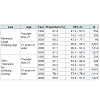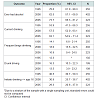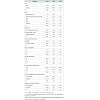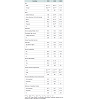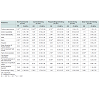Journal of Addiction & Prevention
Controlling Underage Drinking: Fear of Law Enforcement or Internalized Normative Values?
Won Kim Cook
- Alcohol Research Group, Public Health Institute, 6475 Christie Avenue, Suite 400, Emeryville, CA94608, USA
*Address for Correspondence: Won Kim Cook, Alcohol Research Group, Public Health Institute, 6475 Christie Avenue, Suite 400, Emeryville, CA94608, USA, Tel: 510-597- 3440; Fax: 510-985-6459; E-mail: wcook@arg.org
Citation: Cook WK. Controlling Underage Drinking: Fear of Law Enforcement or Internalized Normative Values? J Addiction Prevention. 2013;1(2): 6.
Copyright © 2013 Cook WK. This is an open access article distributed under the Creative Commons Attribution License, which permits unrestricted use, distribution, and reproduction in any medium, provided the original work is properly cited.
Journal of Addiction & Prevention |ISSN: 2330-2178 | Volume: 1, Issue: 2
Submission: 02 October 2013 | Accepted: 15 November 2013 | Published: 22 November 2013
Abstract
Background: Previous research on alcohol control policies has generally taken a deterrence perspective. Whether internalized normative values, consistent with the changes intended by alcohol policies, were a potential base for securing public compliance with them has received little research attention. To fill this gap, this study examined whether under age young adult’s support for underage drinking laws was associated with their alcohol use.
Methods: National Alcohol Surveys (NAS) data collected in 1995-2005 were used. Multivariate logistic regression analyses were conducted. Covariates included: sex, race, education level, household income, positive alcohol expectancies, the perceived likelihood of law enforcement, and the availability and affordability of alcohol.
Results: Controlling for other covariates, support for underage drinking laws was significantly associated with some drinking outcomes. Underage young adults who were not supportive of the minimum legal drinking age law were more likely to engage in frequent binge drinking (OR=3.08) and drinking driving (OR=4.17), and to have initiated drinking at age 16 or younger (OR=2.37). Those who indicated a lower degree of support for the zero-tolerance drunk driving law had higher odds of drinking driving (OR=4.36), as well as higher odds of having ever had alcohol (OR=5.46), current drinking (OR=5.36), and having initiated drinking at the age of 16 or younger (OR=3.09). The perceived likelihood of law enforcement was protective only from frequent binge drinking (OR=0.09).
Conclusion: A clear articulation of potential harms associated with underage drinking to help legitimize underage drinking laws, along with their rigorous enforcement, may help reduce underage drinking.
Introduction
Minimum legal drinking age (MLDA) laws and zero-tolerance (ZT) drunk driving laws have been the cornerstone of policy efforts to control underage drinking in the United States. Cumulative evidence points to the relative effectiveness of the policy of limiting youth access to alcohol through the MLDA law and reinforcing it with the ZT law. Underage drinking laws have been associated with decreases in alcohol-related traffic crashes, injuries and/or fatalities for the targeted age groups [1-4]. They are also linked with a decline in the proportion of underage drinkers who drive after drinking [5,6] and a reduction in heavy episodic drinking, especially among underage males [7]. Still, the prevalence of underage drinking has remained high. Between 2005 and 2011, about one in five high school seniors reported binge drinking, about one in ten reported extreme binge drinking of 10 drinks or a day, and about 6% reported even more extreme binge drinking of 15 drinks or more a day [8].
Previous research on alcohol control policy has generally taken the deterrence perspective, which postulates that the effectiveness of a law lies in the perceptions of a high likelihood of formal punishment following violation of that law. Research has thus found that limited enforcement of underage drinking laws allowed easy access to alcohol of underage youth, undercutting the effectiveness of these laws [9-12]. While this focus on enforcement is certainly appropriate, what may have been overlooked is that laws can affect behavior not just by instilling fear of formal sanction but also by changing normative values of citizens in a manner consistent with the intended goals of the laws.
Normative values have long been recognized by social theorists as a potential base for securing public compliance with laws. From this perspective, if people regard a law as legitimate and compliance with it appropriate, they will voluntarily abide by it [13]. Legal and social systems cannot function if they can influence citizens only through formal sanctions [14,15]. Enforcement requires a large expenditure of resources to have any noticeable effect on citizen’s assessments on the likelihood of being detected and punished [16]. For behaviors like underage drinking that may often be considered socially acceptable and are likely to occur pervasively with little stigma, relying on enforcement alone may be impractical. The primary impact of laws may lie in changing behaviors by instilling fear of formal punishment, but over time laws may condition citizens to voluntarily modify their behavior by influencing their personal perceptions, values and norms [17].
The current study explores whether support for underage drinking laws-an indication that normative values consistent with such laws are internalized in underage young adults-is associated with underage drinking. Alcohol control policies including underage drinking laws are designed to modify the environment in a way to reduce or prevent drinking and drinking-related problem behaviors. However, policies are unlikely to determine behaviors in a mechanical way. Rather, their effects may be mediated or moderated by various cultural, social, and economic factors. In the current literature on alcohol policies, enforcement of policies has been identified as one of such factors, and a very prominent one [11,12,18]. An individual’s normative judgment about (or support for) the laws-i.e. whether he (she) considers them legitimate or appropriate-or the behaviors the laws are intended to deter may be another. At the very least, some drinking behaviors may be addressed more effectively through coercion (i.e. by enforcement of laws), and others by instilling normative values embodied in the law, in part by articulating and publicizing the health and social consequences of the very behaviors the laws are intended to deter. Recent research has investigated the influence of community disapproval of adolescents’ alcohol use, as perceived by adolescents, and adolescent’ own drinking beliefs (for example, perceived harm of alcohol use) [19,20]. However, little research has been reported on adolescents’ or underage young adults’ support for underage drinking laws or their judgments about specific behaviors the laws are intended to deter.
Three specific research questions are addressed in the current study: 1) to what extent those younger than 21 years support the MLDA and ZT laws; 2) to what extent underage drinking is associated with support for the laws and with the perceived likelihood of being subjected to enforcement of the laws; and 3) what specific underage drinking behaviors are associated with the former and what behaviors are associated with the latter. Covariates included in the multivariate models are other predictors of underage drinking that have been widely investigated-i.e. the influence of significant others, positive alcohol expectancies, and availability and affordability of alcohol. Demographic variables such as sex, race, education level, and annual household income are also included in those models.
Materials and Methods
DataData of the National Alcohol Surveys (NAS) conducted by the Alcohol Research Group in 1995, 2000, and 2005 were used for the current study. The 1995 NAS data were collected via in-person interviews of adults 18 ages or older sampled by a stratified, clustered, multi-stage design, and the 2000 and 2005 data through random-digit-dialing computer-assisted telephone interviews. Informed consent was obtained prior to each interview. The 1995, 2000, and 2005 NAS include nationwide probability samples of 4,936, 7,612, 6,919 respondents with response rates of 79%, 58%, and 50%, respectively. The 2000 and 2005 NAS response rates, although lower than those of many face-to-face surveys, are typical of recent U.S. telephone surveys in a time of increasing barriers to random-digit-dial studies [21]. Details on NAS methodology are provided elsewhere [22]. The 1995 underage adult sample included 255 persons ages 18-20, and the 2000 and 2005 samples included 402 and 223 persons, respectively, of the same age profile.
Measures
Drinking outcomesCurrent alcohol use was assessed by the question whether the respondent had a whole drink of any alcoholic beverage in the last twelve months. Frequent binge drinking indicates that the respondent had at least five or six glasses (or twelve-ounce cans or bottles) more than half the time he (she) drank. Drinking driving was assessed by the combination of two questions: 1) whether the respondent had driven a motor vehicle in the last twelve months and 2) if so, whether he(she) had driven a car when he(she) had drunk enough to be trouble if the police had stopped him(her).
Since support for the MLDA and ZT laws was not directly measured in the NAS, proxies were used in the current study. Support for the MLDA law was assessed using a dichotomous variable indicating the view that the legal drinking age “should be raised or remain the same” versus “should be lowered.” Categorical responses to the question, “How much drinking is all right when going to drive a car?” recoded into a dichotomous variable of “no drinking” versus “some drinking” was used as a proxy for support for the ZT law.
A composite index for positive alcohol expectancies was constructed using three questions that asked about the agreement or disagreement with the following statements: “Getting drunk is an innocent way of having fun”; “Having a drink is one of the pleasures of life”; and “Having a drink with someone is a way of being friendly.” Perceived likelihood of law enforcement was assessed by the question whether “drinking can get you into trouble with the police or authorities”is an important reason for abstaining from alcoholic beverages or being careful about the amount of drinking. The influence of significant others was assessed by the question whether “family or friends get upset when you drink” is an important reason for abstaining from or being careful about the amount of drinking. Alcohol availability was assessed by the question whether “it’s easy to buy alcoholic beverages during the evening.” Alcohol affordability was assessed by the question whether “alcohol’s costing too much money” is an important reason for abstaining from or being careful about the amount of drinking.
Univariate analyses were conducted using the 1995-2005 NAS data to obtain point estimates to track the changes in the proportions of persons who supported underage drinking laws, as well as prevalence of underage drinking. Chi-square tests were conducted using the same data to examine the associations of demographic characteristics and other covariates with support for underage drinking laws. The 2000 NAS data were used to fit a series of logistic regression models to examine the associations of support for underage drinking laws with drinking behaviors. The 2000 NAS yielded a larger sample of underage young adults than the 2005 NAS. Additionally, key questions concerning opinions about alcohol-related laws were randomly balloted in the 2005 survey to reduce the time needed for interviews, which led to a sample too small for multivariate analyses. In all analyses, survey estimation procedure of STATA Version 10 was used to accommodate all design, non-response, and poststratification weights.
Results
Underage drinking and support for the MLDA and ZT lawsAs Table 1 shows, while the proportion of adults who supported the MLDA law decreased slightly from 92.2% in 1995 to 87.2% in 2005, the proportion of underage young adults who supported the MLDA law plunged from 87.4% in 1995 to just over 60 percent in 2005. (Given the overlaps in confidence intervals, the changes over time were not statistically significant.) In contrast, support for the ZT law remained overwhelmingly high in all three years. Support for the ZT law was particularly high among underage young adults, with close to 90 percent of them supporting it. While the proportion of persons who supported the ZT law slightly eroded from 1995 to 2005 among both adults of drinking ages and underage young adults, the change was significant only for adults and from 1995 to 2000.Therefore, it appears that the legitimacy of this law was firmly established among underage adults.
Predictors of underage drinking
Table 5 presents the results of multivariate logistic regression analyses to examine the associations of support for underage drinking laws and drinking outcomes. Controlling for other covariates, the two variables each indicating a lower degree of support for the laws were significantly associated with some drinking outcomes. Those who indicated that “the minimum drinking age should be lowered” (thus not supportive of the MLDA) had significantly higher odds of frequent binge drinking (OR=3.08), drinking driving (OR=4.17), and having initiated drinking at age 16 or younger (OR=2.37). A lower degree of support for the ZT law was significantly associated with all outcomes but frequent binge drinking. Those who indicated that some drinking, as opposed to no drinking, may be allowed before driving (thus less supportive of the ZT law) had several times higher odds of having ever had alcohol (OR=5.46), being a current drinker (OR=5.36), drinking driving (OR=4.26), and having initiated drinking at the age of 16 or younger (OR=3.09). The perceived likelihood of law enforcement was highly protective from frequent binge drinking (OR=0.09), but it was not significantly associated with any other drinking outcomes. Positive alcohol expectancies were predictive of all drinking outcomes but drinking driving.Discussion
The current study found that a lower degree of support for underage drinking laws was significantly associated with greater alcohol assumption. These findings suggest that internalized normative values may indeed influence underage drinking. Due to the cross-sectional design of the NAS, however, it is difficult to determine if support for underage drinking laws reduces drinking or the experience of drinking leads to a lower degree of support for the laws. Longitudinal research is warranted to address this limitation.
It is worth noting that only the two variables that serve as proxies of support for underage drinking laws are significantly associated with drinking driving. These findings suggest that normative judgments about drinking driving or the laws intended to prevent it may indeed be deterrents to such behaviors.
The findings that the lack of support for the ZT law was associated with increased odds of drinking driving, whereas the perceived likelihood of law enforcement was not, are highly significant. They suggest that what discourages underage drinking driving more effectively may not be a fear of legal sanction but, rather, internalized normative values that drinking driving is not acceptable. As previously suggested [23], the ultimate deterrent to behaviors with potentially grave moral, health, or social consequences, such as drinking driving that could harm oneself or others, may be the internalized values against such behaviors, rather than the perceived likelihood of formal sanctions. Results of the univariate analysis that normative support for the ZT law was overwhelmingly high among underage adults also suggest that normative values embodied in this law may have been internalized in the vast majority of underage of adults.
Still, the robust association between the perceived likelihood of law enforcement and frequent binge drinking should also be noted. Even with occasionally publicized fatalities caused by binge drinking, young people may perceive binge drinking to be harmless and pleasurable behavior over which they can forge bond with their peers. This is also supported by the findings of the current study that link positive alcohol expectancies with binge drinking and all the other drinking outcomes but drinking driving. While it may thus be difficult to morally dissuade underage young adults from binge drinking, it may be easier to detect binge drinking among underage adults because of the rowdiness that they may exhibit in the course of such drinking. This combination of the low moral implications and high detect ability may render binge drinking to be the type of behavior that can be effectively addressed by enforcement of alcohol related laws.
To a large extent, our findings suggest that a multi-pronged approach that uses different strategies for different types of drinking behaviors may be warranted, as some behaviors may be better controlled by enforcement of laws and others by reasoning or moral persuasion. Combining moral persuasion and the threat of legal sanction to enhance their synergistic effects may be effective in addressing various types of harmful drinking. As Ross contended [16], if the credibility of a law is established through rigorous enforcement, the law may eventually affect related social norms through increased feelings of shame and guilt.
Several limitations of the current study should be noted. Firstly, as stated above, the cross-sectional design of the NAS made it difficult to establish causal relations between drinking outcomes and predictors of interest. Secondly, since all data were collected via self-report, reporting bias may be present. Thirdly, since the NAS was designed to cover a wide range of factors, prevalence, and consequences of drinking for all adults-thus not designed to focus solely on underage drinking-some of the measures were not optimal for the current study. The measure that assessed positive alcohol expectancies was constructed using only three items and thus failed to cover a wide range of expectancies concerning, for example, relaxation and cognitive and sexual enhancement. The measure for frequent binge drinking was assessed by the item whether that behavior occurred “more than half the time” the respondent drank in the past year, but how frequently the respondent drank was not considered.
Despite these limitations, the current study adds to the literature in a meaningful way. Using national, representative samples was a clear strength of the study. More importantly, findings of the current study shed light on a little investigated area-namely whether normative values embodied in the law are internalized in members of the target group and help modify their behavior. This is an area that needs to be better understood to improve intervention efforts. Past research on the effects of underage alcohol control policies has generally taken a more or less ecological approach, examining the effects of nationalor state-level policies on aggregate statistics of individual-level outcomes such as injuries or fatalities [24-28]. A strong emphasis on enforcement of alcohol policies is also evident in the current literature on alcohol policies [9,11]. Whether policies have been established as legitimate and affect individual-level drinking behaviors has received little research attention. The current study attempted to initiate an investigation of this issue.
Acknowledgements
This study was supported by the National Institute on Alcohol Abuse and Alcoholism grant P50AA05595.References
- Shults RA, Elder RW, Sleet DA, Nichols JL, Alao MO, et al. (2001) Reviews of evidence regarding interventions to reduce alcohol-impaired driving. Am J Prev Med 21: 66-88.
- Fell JC, Fisher DA, Voas RB, Blackman K, Tippetts AS (2007) The relationship of 16 underage drinking laws to reductions in underage drinking drivers in fatal crashes in the United States. Annu Proc Assoc Adv Automot Med 51: 537-557.
- Mccartt AT, Hellinga LA, Kirley BB (2010) The effects of minimum legal drinking age 21 laws on alcohol-related driving in the United States. J Safety Res 41: 173-181.
- Voas RB, Tippetts AS, Fell JC (2003) Assessing the effectiveness of minimum legal drinking age and zero tolerance laws in the United States. Accid Anal Prev 35: 579-587.
- Wagenaar AC, O’malley PM, Lafond C (2001) Lowered legal blood alcohol limits for young drivers: effects on drinking, driving, and driving-after-drinking behaviors in 30 states. Am J Public Health 91: 801-804.
- Roeper PJ, Voas RB (1999) Underage drivers are separating drinking from driving. Am J Public Health 89: 755-757.
- Carpenter C (2004) How do Zero Tolerance Drunk Driving Laws work? J Health Econ 23: 61-83.
- Patrick ME, Schulenberg JE, Martz ME, Maggs JL, O’malley PM, et al. (2013) Extreme Binge Drinking Among 12th-Grade Students in the United States: Prevalence and Predictors. JAMA Pediatr 167: 1019-1025.
- Forster JL, Mcgovern PG, Wagenaar AC, Wolfson M, Perry CL, et al. (1994) The ability of young people to purchase alcohol without age identification in northeastern Minnesota, USA. Addiction 89: 699-705.
- Grube JW (1997) Preventing sales of alcohol to minors: results from a community trial. Addiction 92: S251-S260.
- Wagenaar AC, Toomey TL, Erickson DJ (2005) Complying with the minimum drinking age: effects of enforcement and training interventions. Alcohol Clin Exp Res 29: 255-262.
- Preusser DF, Williams AF (1992) Sales of alcohol to underage purchasers in three New York counties and Washington, D.C. J Public Health Policy 13: 306-317.
- Tyler TR (2006) Why People Obey the Law, Princeton University Press, Princeton, NJ.
- Engstrom RL, Giles MW (1972) Expectations and images: A note on diffuse support for legal institutions. Law & Society Review 6: 631-636.
- Scheingold SA (1974) The Politics of Rights. Yale University Press, New Haven, CT.
- Ross HL (1981) Deterrence of the Drinking Driver. Lexington BooksLexington MA.
- Snortum JR (1988) Deterrence of alcohol-impaired driving: An effect in search of a cause. In: Laurence MD, Snortum JR, Zimring FE (Eds.) Social Control of the Drinking Driver. University of Chicago Press, Chicago, IL.
- Babor T, Caetano R, Casswell S, Edwards G, Giesbrecht N, et al. (2010) Alcohol: No Ordinary Commodity: Research and Public Policy, Oxford University Press, New York, NY.
- Lipperman-Kreda S, Grube JW, Paschall MJ. (2010) Community norms, enforcement of minimum legal drinking age laws, personal beliefs and underage drinking: an explanatory model. J Community Health 35: 249-257.
- Lipperman-Kreda S, Paschall MJ, Grube JW (2009) Perceived localenforcement, personal beliefs, and underage drinking: an assessment of moderating and main effects. J Stud Alcohol Drugs 70: 64-69.
- Midanik LT, Greenfield TK (2003) Telephone versus in-person interviews for alcohol use: results of the 2000 National Alcohol Survey. Drug Alcohol Depend 72: 209-214.
- Midanik LT, Greenfield TK (2003) Defining ‘current drinkers’ in national surveys: results of the 2000 National Alcohol Survey. Addiction 98: 517-522.
- Berger DE, Marelich WD (1997) Legal and social control of alcohol-impaired driving in California: 1983-1994. J Stud Alcohol 58: 518-523.
- Ferguson SA (2012) Alcohol-impaired driving in the United States:contributors to the problem and effective countermeasures. Traffic Inj Prev 13: 427-441.
- WagenaarAC, Maldonado-Molina MM, Ma L, Tobler AL, Komro KA (2007) Effects of legal BAC limits on fatal crash involvement: analyses of 28 states from 1976 through 2002. J Safety Res 38: 493-499.
- Gruenewald PJ, Freisthler B, Remer L, Lascala EA, Treno A (2006) Ecological models of alcohol outlets and violent assaults: crime potentials and geospatial analysis. Addiction 101: 666-677.
- Treno AJ, Johnson FW, Remer LG, Gruenewald PJ (2007) The impact of outlet densities on alcohol-related crashes: a spatial panel approach. Accid Anal Prev 39: 894-901.
- Paschall MJ, Grube JW, Kypri K (2009) Alcohol control policies and alcohol consumption by youth: a multi-national study. Addiction 104: 1849-1855.


